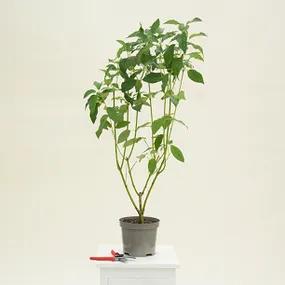Golden Twig Dogwood Hedge Plants
Honest Delivery PricesCornus sericea Flaviramea
Hedge Plants- Golden-Yellow young stems
- Ornamental shrub
- Max. Height: 3m
- RHS Award of Garden Merit
Recommended extras
Description
Cornus sericea Flavimarea Dogwood
Delivered by Mail Order Direct from our Nursery with a Year Guarantee
Cornus sericea Flavimarea, also known as Golden-Twig dogwood (or sometimes Cornus stolonifera Flaviramea), is a vigorous, suckering shrub. Its young stems are a clean golden yellow colour and developing an olive-green tinge as they reach the end of their first year. Which is perfect, because that is when you cut them back. The golden-twig dogwood is usually grown with other dogwoods in an ornamental display. We would suggest three colours (red, purple and yellow go very well together) with three plants of each variety occupying about 3 sq metres. It will light your garden every day from late October to the end of March unless the flower arranger of the house gets there first... Cornus sericea Flavimarea loves growing in damp ground and will reach 3 metres eventually if it is not coppiced.
Have a look at our full range of dogwood shrubs and hedging plants
Cornus sericea Flavimarea plants are delivered bareroot during winter (Nov-April) and are graded by their height in centimetres above the ground when planted.
History & uses of Yellow dogwood:
This variety was bred right at the end of the 19th Century. It has won an RHS Award of Garden Merit so it has stood the test of time.
Planting Instructions
Growing Cornus sericea Flavimarea plants:
Cornus sericea Flavimarea loves damp soils. The only essential preparation is to kill the weeds while: improving the soil with some well-rotted manure and/or compost helps to improve the production of the young coloured stems.
After Care
After planting Cornus sericea Flavimarea, the most important thing to do is water it in dry weather. Watering should be thorough, so the ground is soaked. Let the soil almost dry out before watering again. You will also need to weed around the plants until they are established. Watering & weeding will be necessary for at least a year after planting.
Trimming Dogwood plants: To get the best bark colour bark you need to encourage new growth from the base of the plant. Do this by coppicing (hard pruning), starting in the first year after planting. In March, use clean secateurs to cut all the stems down to about 15cm, 6 inches, from ground level, varying the height of the cuts if you don't want the shape to become too uniform. After that, apply a good blanket of mulch, without touching, the plants. You can do this every year, but every other year is sufficient and better for the local wildlife.
Hygiene & Diseases: Dead, damaged or diseased wood can be pruned off as soon as it appears. Burn or dispose of any diseased material, do not compost it.
After planting Cornus sericea Flavimarea, the most important thing to do is water it in dry weather. Watering should be thorough, so the ground is soaked. Let the soil almost dry out before watering again. You will also need to weed around the plants until they are established. Watering & weeding will be necessary for at least a year after planting.
Trimming Dogwood plants: To get the best bark colour bark you need to encourage new growth from the base of the plant. Do this by coppicing (hard pruning), starting in the first year after planting. In March, use clean secateurs to cut all the stems down to about 15cm, 6 inches, from ground level, varying the height of the cuts if you don't want the shape to become too uniform. After that, apply a good blanket of mulch, without touching, the plants. You can do this every year, but every other year is sufficient and better for the local wildlife.
Hygiene & Diseases: Dead, damaged or diseased wood can be pruned off as soon as it appears. Burn or dispose of any diseased material, do not compost it.

 Img 1.webp)
 Img 1.webp)
